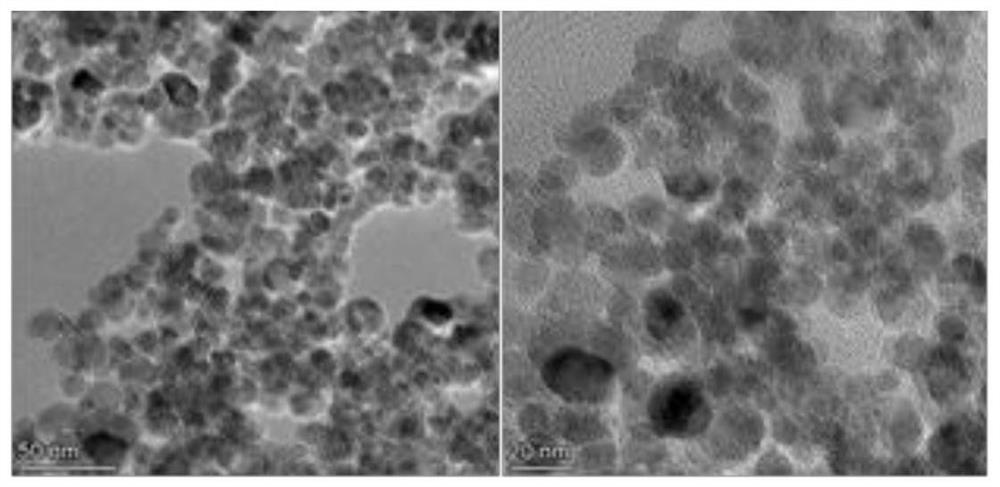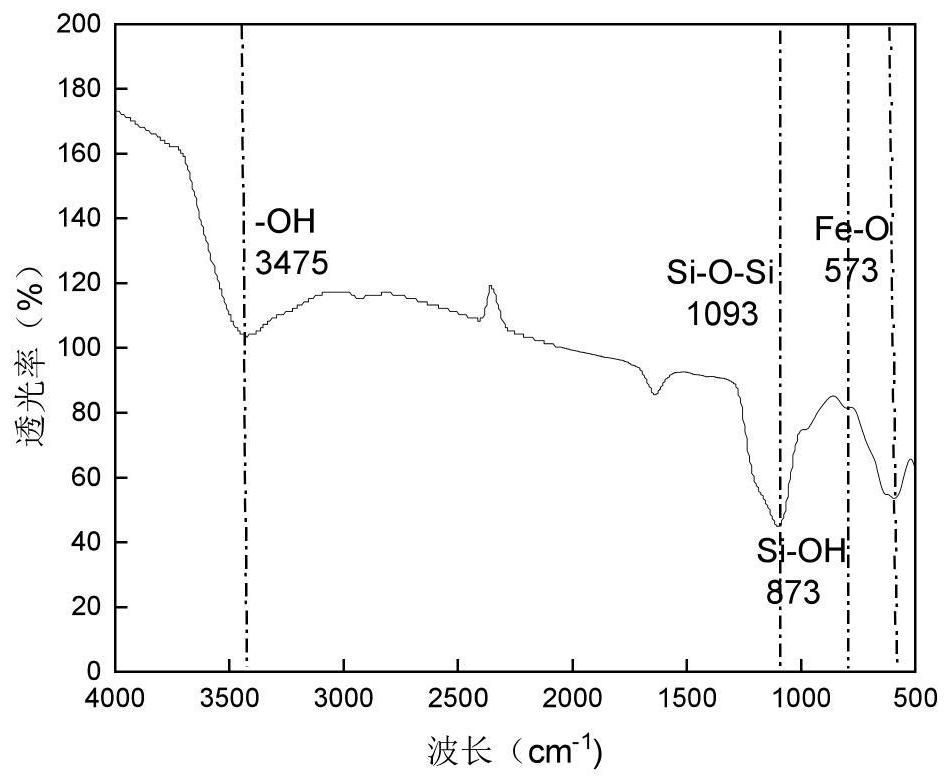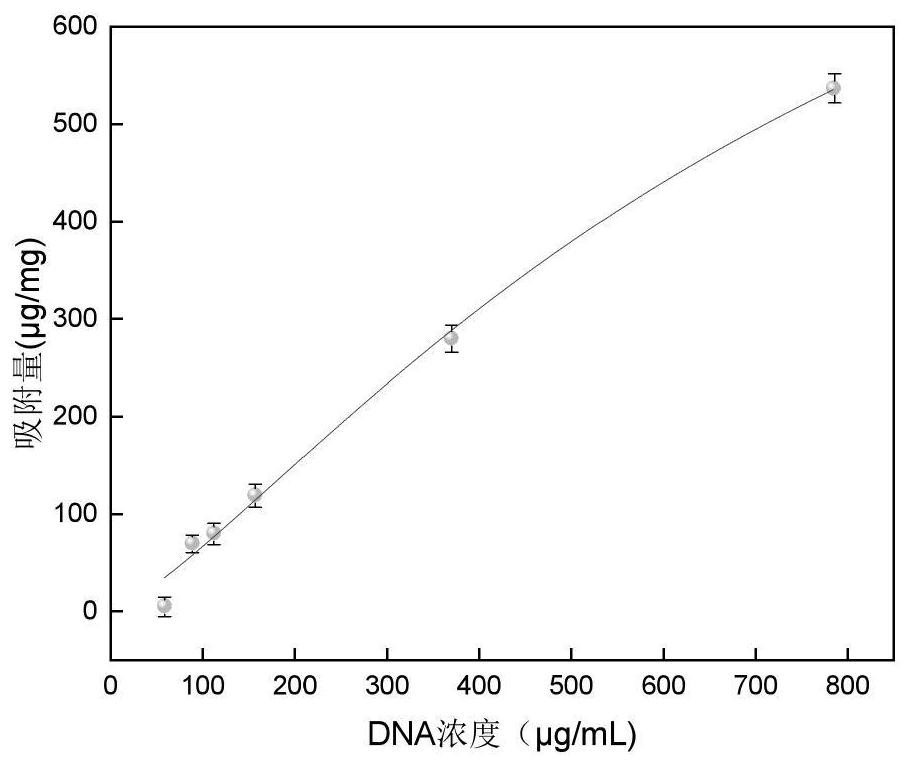Magnetic bead for efficiently adsorbing extracellular DNA in environment, and preparation method thereof
A magnetic bead and high-efficiency technology, which is applied in the field of magnetic beads and its preparation for high-efficiency adsorption of extracellular DNA in an environment, can solve the problem of insufficient adsorption specificity and achieve high specificity
- Summary
- Abstract
- Description
- Claims
- Application Information
AI Technical Summary
Problems solved by technology
Method used
Image
Examples
Embodiment 1
[0021] 1) Take 4g nFe 3 o 4 (particle size of 15nm) was dissolved in 80mL of water, 8g of tetraethyl orthosilicate (TEOS) and 75g of glycerin were added, and the pH of the mixture was adjusted to 4.2 with glacial acetic acid. The mixture was then stirred and heated at 90°C for 2 hours. After the reaction is complete, the product is cooled and separated from the solution by a magnet. The separated solids were washed with water and ethanol, respectively, to obtain clean supported SiO 2 Fe 3 o 4 Nanoparticles (SiO 2 @nFe 3 o 4 ).
[0022] 2) 1g of SiO prepared in the above steps 2 @nFe 3 o 4 Disperse in 200mL ethanol solution, add 1g CTAB, and continuously stir and reflux at 80°C for 12h. The solid material was recovered with a magnet and washed with water and ethanol, respectively. The sample was then dispersed in 100 mL of an ethanol solution containing 1 g of ammonium nitrate and refluxed at 80° C. for 24 hours. The solid matter was recovered by a magnet and wash...
Embodiment 2
[0025] 1) Take 2g nFe 3 o 4(Particle size is 30nm) was dissolved in 100mL of water, and then 2g of tetraethyl orthosilicate (TEOS) and 20g of glycerin were added, and the pH of the mixture was adjusted to 5.0 with glacial boric acid. The mixture was then stirred and heated at 70°C for 1 hour. After the reaction is complete, the product is cooled and separated from the solution by a magnet. The separated solids were washed with water and ethanol, respectively, to obtain clean supported SiO 2 Fe 3 o 4 Nanoparticles (SiO 2 @nFe 3 o 4 ).
[0026] 2) 2g of the SiO prepared by the above steps 2 @nFe 3 o 4 Disperse in 200mL methanol solution, add 1g P123, and continuously stir and reflux at 60°C for 6h. The solid material was recovered with a magnet and washed with water and ethanol, respectively. The sample was then dispersed in 100 mL of methanol containing 1 g of ammonium nitrate and refluxed at 60° C. for 12 hours. The solid matter was recovered by a magnet and wash...
Embodiment 3
[0029] 1) Take 5g nFe 3 o 4 (particle size of 25nm) was dissolved in 200mL of water, and then 20g of tetraethyl orthosilicate (TEOS) and 200g of glycerol were added, and the pH of the mixture was adjusted to 3.0 with glacial acetic acid. The mixture was then stirred and heated at 95°C for 3 hours. After the reaction is complete, the product is cooled and separated from the solution by a magnet. The separated solids were washed with water and ethanol, respectively, to obtain clean supported SiO 2 Fe 3 o 4 Nanoparticles (SiO 2 @nFe 3 o 4 ).
[0030] 2) 3g of SiO obtained in the above steps 2 @nFe 3 o 4 Disperse in 300mL ethanol solution, add 6g CTAB, and continuously stir and reflux at 90°C for 12h. The solid material was recovered with a magnet and washed with water and ethanol, respectively. The sample was then dispersed in 100 mL of ethanol containing 6 g of ammonium nitrate and refluxed at 90° C. for 36 hours. The solid matter was recovered by a magnet and wash...
PUM
| Property | Measurement | Unit |
|---|---|---|
| Specific surface area | aaaaa | aaaaa |
| The average particle size | aaaaa | aaaaa |
| Specific surface area | aaaaa | aaaaa |
Abstract
Description
Claims
Application Information
 Login to View More
Login to View More - R&D
- Intellectual Property
- Life Sciences
- Materials
- Tech Scout
- Unparalleled Data Quality
- Higher Quality Content
- 60% Fewer Hallucinations
Browse by: Latest US Patents, China's latest patents, Technical Efficacy Thesaurus, Application Domain, Technology Topic, Popular Technical Reports.
© 2025 PatSnap. All rights reserved.Legal|Privacy policy|Modern Slavery Act Transparency Statement|Sitemap|About US| Contact US: help@patsnap.com



